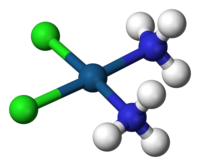
Photo from wikipedia
Abstract Four coordination polymers, [CuCl(cptpy)·2H2O]n (1), [Mn2Cl2(cptpy)2(phdat)H2O]n (2) and [Ln(cptpy)3]n (Ln = La (3), Pr (4)) (Hcptpy = 4'-(4-carboxyphenyl)-2,2':6',2''-terpyridine, phdat = 2,4-diamino-6-phenyl-triazine) have been hydrothermally synthesized and characterized by IR spectra,… Click to show full abstract
Abstract Four coordination polymers, [CuCl(cptpy)·2H2O]n (1), [Mn2Cl2(cptpy)2(phdat)H2O]n (2) and [Ln(cptpy)3]n (Ln = La (3), Pr (4)) (Hcptpy = 4'-(4-carboxyphenyl)-2,2':6',2''-terpyridine, phdat = 2,4-diamino-6-phenyl-triazine) have been hydrothermally synthesized and characterized by IR spectra, X-ray single-crystal diffraction, powder X-ray diffraction (PXRD), elemental analyses and thermogravimetric analyses (TGA). Compounds 1, 3 and 4 exhibit 2D or 3D structures comprising 1D linear chain connected by π…π stacking interactions. While, compound 2 contains two kinds of 1D chains, of which one is a linear chain and the other is a ladder chain, and further extends to 3D structure by π…π stacking and hydrogen bonding interactions. The electrochemical analysis shows that compound 1 has good catalytic activities for the reductions of both NaNO2 and H2O2, and is a potential catalytic material. Magnetic analysis indicates that compound 2 exhibits antiferromagnetic behavior.
Journal Title: Journal of Solid State Chemistry
Year Published: 2019
Link to full text (if available)
Share on Social Media: Sign Up to like & get
recommendations!